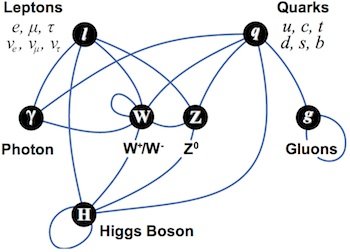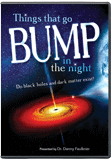
The God Particle and the God of Particles
Abstract
The so-called “God Particle” may not be relevant to many practical aspects of our daily lives but it brings up an opportunity to consider the meaning of the way the universe is made.
The recent announcement (on July 4, 2012)1 of the possible discovery of a subatomic particle called the Higgs boson has generated a stir among physicists. The CERN research accelerator laboratory in Switzerland has detected a new particle from proton-proton collisions. This new particle appears to be of the right mass to be the Higgs boson famously known for some time as the “God Particle.” The existence of the Higgs particle has been debated since 1964 when physicist Peter Higgs proposed the theory. People without much knowledge of physics may wonder what all the excitement is about. On one level the discovery is not about origins primarily, but is about understanding the physics of physical space and the properties of matter. On the other hand, the Higgs boson is relevant to Big Bang theory, at least in the view of some, so they may argue this discovery validates the Big Bang. Though we are finite creatures, as human beings we want to understand the universe we are part of. The so-called “God Particle” may not be relevant to many practical aspects of our daily lives, but it brings up an opportunity to consider the meaning of the way the universe is made.

An example of simulated data modeled for the CMS particle detector on the Large Hadron Collider (LHC) at CERN. The lines represent the possible paths of particles produced by the proton-proton collision in the detector while the energy these particles deposit is shown in blue. Public domain image from Wikimedia Commons.
The Higgs boson was called the “God Particle” in the 1992 book The God Particle: If the Universe is the Answer, What is the Question? by physicist Dr. Leon Lederman. The book was about particle physics. Most physicists would say the Higgs boson has nothing to do with God. Indeed physicists generally dislike the term “the God Particle.”2 If there is anything it has in common with God it may be the parallel that it has been something very hard for physicists to prove the existence of. Even now after the July 4 announcement, scientists are debating various aspects of the discovery. Indeed billions of dollars and hundreds of scientists and engineers have been at work on the task of looking for this elusive particle.
In 2011 Christian apologist Alister McGrath called the Higgs boson the “particle of faith” due to it being something physicists believed in because it answers some important questions, though its existence could not be proven. This is like faith in God, because believers in God would say His existence also explains important things, and so we have reason to accept his existence by faith. McGrath points out:
Science often proposes the existence of invisible (and often undetectable) entities – such as dark matter – to explain what can be seen. The reason why the Higgs boson is taken so seriously in science is not because its existence has been proved, but because it makes so much sense of observations that its existence seems assured. In other words, its power to explain is seen as an indicator of its truth. There’s an obvious and important parallel with the way religious believers think about God. While some demand proof that God exists, most see this as unrealistic. Believers argue that the existence of God gives the best framework for making sense of the world.3
The Standard Model of Particle Physics
To appreciate the significance of the Higgs boson we must be aware of some ideas from modern physics. The Higgs boson is part of a bigger set of ideas that are called the Standard Model of Particle Physics. Most people are aware from basic science that the atom is made up of three particles: the proton, neutron, and electron. These three particles are all stable particles, except that the neutron will quickly decay (i.e., break up into other particles) when separated from the atom. There are, however, other particles that can be encountered in radiation from space or in particle physics experiments. Physicists have a kind of violent curiosity in that they spend billions of dollars building giant accelerators to crash particles together in order to see what happens when particles break apart. It turns out there are a number of other particles than the electron, proton, and neutron which are unstable. They do not exist for long when particles break up in accelerators. Ancient Greeks such as Democritos in the fifth century B.C. were the first to have the concept of atoms. They conceived of them as too small to see, that they were constantly in motion, and they were of different shapes and combined in different combinations to form different materials. This was a great insight that was close to the modern understanding in several ways.4 But two points where their concept was wrong was that the atom was “totally solid” and “indivisible.”
Physicists have arrived at a classification system to describe what has been called the “particle zoo.” Scientists have divided up the proton and neutron into constituent parts, but the electron has so far proved indivisible. From accelerator experiments many particles are ejected from the high energy particle collisions and physicists have studied the properties of these particles. One way of describing the particle zoo is to split all particles into categories called bosons, mesons, baryons, and leptons. The bosons are referred to as force mediating particles because they are all related to fundamental forces. Leptons include electrons, positrons (the anti-particles of electrons), and three types of neutrinos which are very low mass particles. The mesons and baryons have more mass than leptons and are composed of even smaller particles called quarks.
Quarks combine in twos or threes to make other particles. There are six types of quarks, each of which have an anti-particle like them.5, 6 The anti-particles have opposite spins and electric charge. Mesons are composed of one quark and one anti-quark. Baryons include protons and neutrons and are composed of three quarks. Quarks never exist separate from other particles but they seem to successfully explain various observations from particle experiments. They are described as having various qualities that are paired together. The names of the quark characteristics have been arbitrarily chosen to make them sound more familiar to things we can relate to. Some of these qualities, called flavors, are six: up, down, charm, strangeness, top (or truth), and bottom (or beauty). The proton consists of two up quarks and one down quark. A neutron consists of two down quarks and one up quark. An anti-proton is made up of two anti-up quarks and one anti-down quark. An anti-down quark is not the same thing as an up quark.
In this particle zoo there are rules about how the particles can and cannot combine to make other particles. There are many ways in which the spins, electric charges, and other characteristics determine the properties of matter in some way. There are also mathematical functions describing each particle using quantum physics. The electron energy levels in an atom determine the chemical behavior of an element and give it most of the properties we notice for each element in the periodic table. These energy levels are specified by very complex mathematical functions. The nucleus of the atom, where protons and neutrons reside, also has multiple energy levels.7 This all implies that the atom is of a very complex construction. The complexity and orderly rules describing how the particles combine to make other particles and then atoms is an indication of intelligent design.
The design in the atom is somewhat like creating things out of Legos or Lincoln Log toys. A small number of Lego or Lincoln Log pieces can be used to make a variety of different objects. This is similar to how a relatively small number of particles can be used to create all the elements in the periodic table. It also explains a variety of nuclear phenomena. The various Lego pieces each have their own rules about how they combine with other pieces and how they can be used. Thus the Lego pieces are not products of chance, they are designed for building things. Neither are subatomic particles mere products of chance, even though they may be described partially by probability functions. The relative strengths of the fundamental forces in addition to the way particles combine make atoms stable and give the elements their properties. It has been estimated for example that if the proton were more massive by only 0.2 percent, it would be unstable.8 As it is the proton is one of the most stable of all known particles. Life would probably be impossible if the proton were unstable. The way particles are organized in matter is an indication of God’s design.

A diagram summarizing interactions between elementary particles described in the Standard Model. Darkened circles represent types of particles, and blue lines connecting them represent interactions that can take place. Public domain image from Wikimedia Commons.
The fundamental forces are also part of the Standard Model of Particle Physics. Physicists believe there to be four fundamental forces.9 These are gravity, electromagnetism, the weak force, and the strong force. Gravity we are familiar with, but it is actually the weakest of the four forces. The strongest force is the strong force, which is responsible for holding particles together in the nuclei of atoms. The strong force only switches on when nuclear particles get closer than ten thousand billionths of a centimeter from the nucleus. The weak force is stronger than gravity, but weaker than electromagnetism. It has to do with radioactive decay and the stability of the nucleus of the atom. Physicists believe that forces require a boson particle to “mediate” and transfer the force between particles. For electrical and magnetic phenomena the boson particle is the photon, which is a “particle” or quantum of light energy. For gravity physicists believe the mediating particle is something called the graviton (not confirmed experimentally). The weak force is mediated by some exotic particles called the W+, W-, and Z bosons. The particle related to the strong force is something called a gluon. Note that the strong force is related to nuclear binding energy, which is the source of power for nuclear power plants and nuclear weapons.
Physicists are seeking experimental evidence for all these complex ideas from modern physics. Some of these particles are actually observed in particle experiments, such as the W and Z particles. Photons are well understood and are related to a number of practical inventions in electronics and lasers, for example. But the gluons and gravitons are particles which have not been confirmed by experiment. Some mesons are detected to enter the earth’s atmosphere from space. Anti-matter particles have been generated in nuclear or particle experiments by physicists. Other particles like quarks are never observed directly, but their existence is inferred indirectly.
What does the Higgs boson do?
The Higgs boson is part of physicists’ theoretical concepts of what happens in empty space.
In understanding the fundamental forces, the question comes up about why some particles have more mass than others? For example, the top quark is a very massive particle—much more massive than the electron. Physicists believe Higgs bosons are particles that exist in large numbers throughout physical space. We should note that even physical space and time had to be created. Physical space has three dimensions of distance and it has measurable properties even if atoms are not present in it. So as has been pointed out by astronomer Jason Lisle, God created empty space.10 The Higgs boson is part of physicists’ theoretical concepts of what happens in empty space. All other particles have to travel through the Higgs field of Higgs bosons. The Higgs field is thought to cause a kind of resistance to other particles that interact with it. Photons are not affected by the Higgs field since they have no mass, but many other particles such as electrons or protons do interact with it. Physicists believe that all particles initially had no mass and traveled at the speed of light until they acquired mass from the Higgs field. Acquiring mass meant that they slowed down and interacted with the fundamental forces. It has been likened to imagining a ball moving through molasses. Some balls do not stick much to the molasses and some balls are stickier. The “stickier” particles in the Higgs field have more mass.
The Higgs boson has been incorporated into Big Bang theory as part of a theory called “inflation.” Physicist Alan Guth proposed the idea of the inflation of the universe.11 In Big Bang theory “inflation” is proposed to explain a particular early stage starting at about 10-36 second in which the universe expands almost instantly, changing size by a factor of 1050 in a minute fraction of a second.12 Inflation was proposed to solve certain problems with Big Bang theory.13 It is the Higgs boson that is believed to make the extremely rapid expansion in inflation theory possible. However, not all cosmologists accept the inflationary universe scenario. So, though the inflation theory has significant support, scientists would still have other possible approaches to Big Bang theory even without it. So, the Higgs boson is currently part of the Standard Model of Particle Physics and an important part of that theory. But, it is not an essential component of Big Bang theory, in the view of all physicists and cosmologists. The Bible teaches the origin of the universe was very different from the Big Bang. Genesis does not explain the physics of subatomic particles in the creation week. On the other hand, Genesis describes God apparently speaking the earth and universe into existence and making the earth into a habitable planet in the space of six days. In contrast, the inflationary Big Bang has a practically instantaneous expansion of the universe followed by a very long process in which particles, atoms, and stars and galaxies form. Stable atoms would not form in the Big Bang until a few hundred thousand years after the beginning, due to the high temperatures. Also in the Big Bang, stars and galaxies would form long before the earth. The Bible on the other hand, has the earth being created before stars.
In the particle experiment searches for the Higgs boson, there are uncertainties in the recent results, even though physicists were very excited. The theory on the Higgs boson does not precisely pin down what its mass should be, but implies it should be between about 115 and 140 GeV/c2. (Note that GeV/c2 is a peculiar mass unit used by particle physicists for measuring subatomic particles, based on the E=mc2 equation.) Theory on the Higgs particle also says it would have no spin and no electric charge, for instance. All that has been measured so far is the particle's mass, which is approximately 125 GeV/c2. This is very plausible for the Higgs particle, but there could be other particles or combinations of particles that could explain the July 4 result also.14, 15 The Higgs experiment detects photons, Z and W bosons, and other particles that are ejected from the proton-proton collision. The mass of the particle is inferred indirectly from considering what particles come out of the collision event. As is the case with many things in particle physics, the Higgs particle decays rapidly and it can decay in multiple ways. Physicists want to measure it a number of times so that they can see which way it decays most often. So, more experiments will be done at CERN over coming months to check the recent results.
Experimental science is fundamentally different than the study of origins. We should keep in mind that no experiment can prove how the universe formed because there is no way to verify for certain that the experiment matches the conditions at the beginning. Furthermore, since we have the inerrant Word of the Creator that tells us how the universe began at His command, we should question the Big Bang theory. The Higgs boson is part of an elaborate scientific model about what makes up space and matter. Scientific models are mental constructs from human imagination and reason that attempt to enable people to understand some aspect of nature. The Standard Model of Particle Physics may or may not be correct about the Higgs boson but as Christians we still have confidence God is holding all things together (Colossians 1:16–17).
Footnotes
- CERN Press Release 17.12, (July 4, 2012), “CERN experiments observe particle consistent with long-sought Higgs boson.” press.web.cern.ch/press/PressReleases/Releases2012/PR17.12E.html.
- Robert Evans, “The Higgs boson: Why scientists hate that you call it the ‘God particle’,” December 14, 2011. news.nationalpost.com/2011/12/14/the-higgs-boson-why-scientists-hate-that-you-call-it-the-god-particle.
- Alister McGrath, “Higgs boson: the particle of faith,” December 15, 2011. www.telegraph.co.uk/science/8956938/Higgs-boson-the-particle-of-faith.html
- Colin A. Ronan, Science: Its History and Development Among the World’s Cultures (New York: Facts on File, 1982), pp. 82–84.
- Jerry Bergman and Don B. DeYoung, “Particle Physics and Paley’s Watch,” Creation Research Society Quarterly 39 (2002): 73–79.
- Chris Quigg, “Elementary Particles and Forces,” in Jefferson Hane Weaver, The World of Physics Volume II, (New York: Simon and Schuster, 1987), 871–892.
- Ralph E. Lapp and Howard L. Andrews, Nuclear Radiation Physics, Fourth Ed. (Upper Saddle River, New Jersey: Prentice Hall, 1972), pp. 284–287.
- Jerry Bergman and Don B. DeYoung, “Particle Physics and Paley’s Watch,” Creation Research Society Quarterly 39 (2002): 73–79.
- Chris Quigg, “Elementary Particles and Forces,” in Jefferson Hane Weaver, The World of Physics Volume II, (New York: Simon and Schuster, 1987), 871–892.
- Jason Lisle, “Spacetime: Virtual Particles, Time, . . . and the Trinity,” Answers 3, no. 1 (2008): 89–91, https://answersingenesis.org/physics/spacetime/. Available online at www.answersingenesis.org/articles/am/v3/n1/spacetime
- Alan H. Guth and Paul J. Steinhardt, “The Inflationary Universe,” in Jefferson Hane Weaver, The World of Physics Volume III, (New York: Simon and Schuster, 1987), pp. 321–348.
- Alex Williams and John Hartnett, Dismantling the Big Bang (Green Forest, Arkansas: Master Books, 2005), pp. 116–124.
- Alex Williams and John Hartnett, Dismantling the Big Bang (Green Forest, Arkansas: Master Books, 2005), pp. 116–124.
- The Week, “What if scientists actually didn't discover the Higgs boson?,” July 11, 2012, theweek.com/article/index/230367/what-if-scientists-actually-didnt-discover-the-higgs-boson.
- Hamish Johnston, “It's a boson, but what sort?,” July 5, 2012, physicsworld.com/cws/article/news/2012/jul/05/its-a-boson-but-what-sort.
Recommended Resources

Answers in Genesis is an apologetics ministry, dedicated to helping Christians defend their faith and proclaim the good news of Jesus Christ.
- Customer Service 800.778.3390
- © 2024 Answers in Genesis





